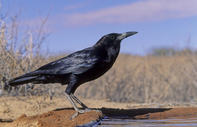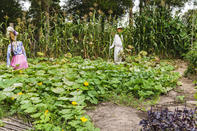Crows may cause extensive losses to livestock as well as to crop, fruit and grape farmers. Increasing numbers are resulting in growing concern over their impact on reptile, small bird and other raptor species.

But, they are not all bad. According to the Endangered Wildlife Trust, crows fulfill a valuable ecological role as scavengers, with their consumption of animal carcasses helping to prevent the spreading of diseases. They also help to keep mice and rat populations under control and their nests are often used by cuckoos or other raptors, such as Greater Kestrels and Lanner Falcons.
Pied Crows and White-necked Ravens
Pied crows (Corvus albus) and white-necked ravens (Corvus albicollis) are the main troublemakers on farms. Adult pied crows are black all over, except for a white collar and upper mantle that extends to the underparts of their breast, body sides and axillaries. Adult pied crows are about 45 cm long, with their wing length varying according to moulting stage and age of the bird.
They are found throughout Southern Africa, but usually stay near farmlands, savanna, urban areas, rubbish dumps, verges of roads and railways. The white-necked raven has a glossy black colour with white collar on the hind neck. Its big arched bill is black with a white tip. Adults are 50 to 54 cm long, with a wingspan of 48 to 43 cm.
They are found throughout South Africa, mostly in mountainous areas, gorges and cliffs, while foraging may take place in more open country. Both species mate for life. The nests are bulky structures made with sticks and roots, with a soft inner lining of mud, dung, wool string or grass.
The mating season varies according to climatic conditions, but is usually from July to November for the white-necked raven and from July to January for the pied crow. Females lay 4 to 5 eggs at a time.
Killing and Feeding Pattern
Pied crows and white-necked ravens cause pretty nasty damage. Their beaks are not sharp enough to puncture flesh, so they usually peck out the eyes of lambs or ewes that are lambing, leaving their prey blind.
They cause extensive livestock loss, especially during times of drought. A carcass that has been opened at the eyes, mouth, umbilicus or anus, is often a sure sign that one of the crow family has been feeding on it.
Management

It is extremely difficult to manage crows. They are not a protected species, so maybe hunted on the farm, but not on public roads or in a municipal area. Some farmers make use of audio and visual deterrents, for example, using reflectors or scarecrows, to scare birds away from vulnerable livestock and crops, while others put nets over their crops to protect it from bird damage.
The use of poison is illegal, since it usually coincides with the destruction of non-target animals, including rare and threatened scavenging raptors. A holistic management approach is needed, which firstly entails a reduction of available food sources. This means better waste containment and removal, especially at informal settlements, dumps and abattoirs.
Trash cans should be secured, bird feeders should be removed and pet food containers should be moved inside. It implies taking better control of prickly pears, since these birds have been implicated in the dispersal of prickly pears in the Nama Karoo. Secondly, it entails better protection of vulnerable livestock.
Pregnant ewes should be moved to smaller camps, where it is easier for a shepherd to look after them, a couple of weeks before lambing and should stay there for a few weeks after lambing, until they and their lambs are less vulnerable.
Nests and eggs may be destroyed, but will probably result in the laying of more eggs. It, therefore, makes more sense to destroy the embryos and return the eggs to the nest, advises the Predation Management Forum.
By Glenneis Kriel